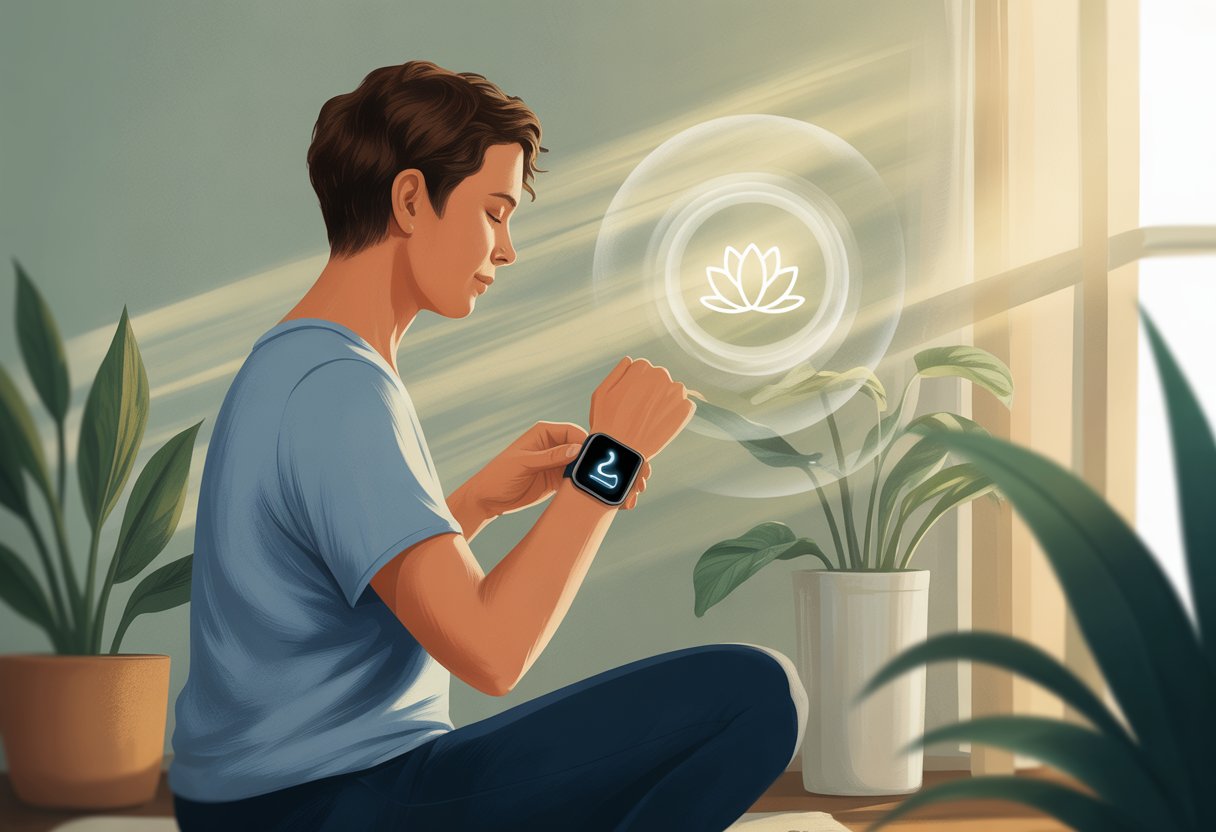Smartwatches aren’t just about counting steps or nagging us to stand up every hour—they can actually help us get our minds together. With just a tap, we can use a smartwatch for some easy mindfulness practice and give our mental health a little boost, all from our wrists.
No need to sit cross-legged or buy fancy incense; our smartwatches are ready to go.

We can set reminders to pause, breathe, and reflect even when life feels chaotic. Some smartwatches include meditation and relaxation features, turning our wrists into little zen coaches.
Honestly, if we’re going to keep glancing at our watches, why not use them to calm down instead of just checking the time?
Why Smartwatches Are the Secret Agents of Mindfulness
Smartwatches don’t just tell us we’re running late—again. These little gadgets help us check in with our minds and bodies, kind of like undercover agents for calm.
How Wearable Tech Redefines Health and Wellness
Let’s be real, most of us forget to breathe sometimes. The modern smartwatch nudges us to pause with just a glance.
Smartwatches often send reminders like “stand up!” or “time to breathe,” and they usually don’t sound as bossy as you’d think. They even hand out stats, fun graphs, and badges when we do something healthy.
These features turn well-being into a bit of a game, not just another boring task. Many devices now include meditation timers and stress alerts right in the software.
With a few taps, we can access mindfulness tools. Some brands walk us through guided exercises step-by-step, which is great because honestly, who wants to mess things up on a tough day?
If you want more details, check out this breakdown of watches in promoting wellness and mindfulness.
The Role of Sensors in Mindfulness Features
The real magic happens inside the watch—those tiny sensors. They track our heart rate, count steps, and sometimes notice stress before we do.
If our heart rate spikes, the watch can suggest a calming exercise. Wearing a smartwatch with advanced sensors gives us instant feedback about our stress or relaxation levels.
This helps us make quick choices, like stepping outside or trying a guided breathing session. All these tools work together, so we get a personalized health assistant that sticks with us—unless we forget to charge it.
Want to see how these features work together? Here’s how smartwatches integrate stress management with mindfulness tools.
Setting Up Your Smartwatch for Mindfulness Awesomeness
Getting our smartwatch ready for mindfulness definitely isn’t rocket science. A few tweaks can make everything way smoother.
With some clever adjustments, our watches help us stay relaxed and focused—and maybe even keep us off our phones for a bit.
Optimizing Display and Notifications for Zen Mode
That glowing smartwatch screen at 2 AM? Yeah, it’s not exactly soothing. We can lower the brightness and pick a calming watch face (soft colors, nothing too wild).
Most smartwatches have a “Do Not Disturb” or “Theater Mode,” so we can block out annoying alerts during meditation or breathing exercises.
Nobody wants a random text or game alert popping up mid-breath. By jumping into settings, we can control which notifications get through.
Let’s keep mindfulness reminders and block the rest—news, social media, all that noise. For tips on setting up mindfulness reminders on Apple Watch, check out Apple’s official guide.
Personalizing Mindfulness Features
Most smartwatches come loaded with mindfulness goodies these days. We can set up daily reminders to breathe, reflect, or practice gratitude.
Don’t be afraid to customize—adjust session length, pick favorite breathing animations, or set the watch to buzz at just the right times. With a little tweaking, our watches nudge us gently instead of nagging us like digital geese.
Apps like Apple’s Mindfulness let us set prompts for morning, evening, or whenever stress hits. The trick is to find a reminder schedule that feels helpful, not bossy.
Managing Battery Life for Peace of Mind
Nothing ruins a relaxing session like a dead smartwatch. To keep the battery going, let’s dim the screen, cut unnecessary notifications, and close unused apps.
Turning on low-power mode before meditating can keep the watch alive while we zone out. If we’re really into mindfulness, charging our watch after waking up or before bed means fewer power worries.
Limiting app animations and vibrations helps, too, so our watch won’t quit during a much-needed breathing break. Setting reminders efficiently—without spamming—also keeps both our battery and our sanity intact.
Mastering Guided Breathing and Meditation with Your Wrist Buddy
We all forget to breathe deeply or relax sometimes—unless our smartwatch gives us a gentle buzz. Let’s actually use this gadget to help us chill out, start healthy routines, and maybe even meditate before we check social media.
Using Guided Breathing Exercises Effectively
Our smartwatches have guided breathing exercises that feel surprisingly official for something happening on our wrists. Most setups, like the Breathe app, walk us through timed inhales and exhales.
We might try a 6-second inhale, 6-second exhale pattern to slow our breathing and clear our heads (or at least try not to think about our to-do lists).
Here’s what usually works for us:
- Find a quiet-ish spot (the couch totally counts).
- Let the watch lead; don’t overthink the inhale/exhale thing.
- Watch the screen for relaxing graphics or just go by the vibration cues.
For more ideas, check out mindful breathing with Garmin, which gives step-by-step tips. These exercises help us focus and stay calm, even when our phone keeps buzzing.
Scheduling Mindfulness Sessions Into Daily Routines
If we only meditate when we’re stressed, we’ll always be behind. Smartwatches let us squeeze mindfulness into even the busiest day by scheduling reminders or setting up short meditation sessions—sometimes just two minutes.
Here are some simple ways to build mindfulness into our routines:
Before breakfast: Open the Breathe app while waiting for the toast.
Lunch break: Take a quick mindfulness session to reset.
Evening: Use the meditation app as we wind down (not while doomscrolling).
We can also try guided meditations from watch-compatible apps and libraries, like Ram Dass’s collection, for a little variety.
Motivation for Making Mindfulness a Habit
We all need a push sometimes. Smartwatch apps send reminders, track progress streaks, or even pop up with encouraging messages (no cookies, sadly, but we can dream).
Here’s how to keep motivation up:
- Track mindfulness streaks and see how many days we can keep it going.
- Share achievements in group chats—someone’s bound to be impressed.
- Use badges, gentle haptics, or silly animations as positive reinforcement.
The more often we schedule and finish these mindfulness exercises, the more our “wrist buddy” helps us relax, focus, and maybe even realize meditation isn’t just for monks or plant lovers.
Tracking Stress and Staring Down Anxiety: Smartwatch Style
Our wrists do more than hold a watch these days. Smartwatches have become handy sidekicks for stress management, tracking our stress levels and even telling us when to breathe (because, yeah, sometimes we forget).
Stress Management and Your Gadget’s Secret Superpowers
Sometimes, we just need a nudge to take a deep breath or step away from the chaos. Many smartwatches now double as stress-fighting gadgets.
They keep tabs on our heartbeats, breathing, and, for the overachievers, our daily stress management score. By tracking sleep, movement, and habits, these wearables can spot when we’re getting tense.
They often send friendly reminders to pause, do guided breathing, or practice quick mindfulness exercises. Sometimes, that little nudge from our wrist is exactly what we need to avoid snapping at our computers.
For example, Garmin smartwatches use sleep tracking and mindfulness tools to support stress management. The best part? No crystals or chants needed—just tap, breathe, and keep scrolling.
Measuring Stress Levels and Heart Rate Variability
Ever wonder how our wrist gadgets know when we’re stressed? It’s not magic—it’s science.
Smartwatches mostly use heart rate variability (HRV), or the time between each heartbeat, to measure stress and predict anxiety. When HRV drops, it’s a good clue we’re getting stressed.
Some watches show this info in a simple graph or daily stress score. Others might buzz when things look rough, nudging us to slow down.
If we notice high stress, it’s probably a good time to try a built-in breathing exercise or step away for a bit. It’s like having a mini wellness coach on our wrist.
Want to know more? Here’s how smartwatches detect stress and help keep anxiety in check.
The Impact of Notifications on Anxiety
Notifications can be both friends and foes. They keep us connected and on schedule, sure, but sometimes the constant buzzes and beeps send our hearts racing like ping-pong balls.
Every new message, email, or app update can get right in our face, and honestly, it’s no wonder our anxiety spikes. Too many notifications just feed into stress rather than calming us down.
Most smartwatches let us pick and choose what alerts show up, so we don’t have to jump every time Aunt Linda sends another cat meme. That’s a relief.
Turning off notifications for non-essential apps really helps. Setting “Do Not Disturb” during mindfulness breaks? Also a great move.
When we take charge of our notification settings, our gadgets stay helpful, not stressful. If we let them, smartwatches will gladly remind us when it’s time to unplug.
Using Health Data for a Mindful Life
Our smartwatches gather a ton of health data right from our wrists. Honestly, it’s a gold mine if we want to be more mindful.
When we check stats like heart rate, blood oxygen, and ECG readings, we start to get a sense of what’s happening inside—no yoga retreat required.
Harnessing Heart Rate and Blood Oxygen for Self-Awareness
Let’s admit it—sometimes our hearts beat like they’re trying out for a rock band. By tracking heart rate during stress, meditation, or excitement, we can see exactly when life gets us “worked up.”
Watching heart rate variability (HRV) gives us clues about how well we handle stress. That’s pretty handy.
Blood oxygen levels aren’t just numbers. When they drop, we might feel tired or foggy—never a good combo.
Smartwatches help us spot patterns, like low oxygen during sleep or after stressful meetings. That’s our cue to take a breath break (or maybe three).
Some smartwatches send reminders if our stats look off. It’s like having a tiny, polite nurse on our wrist.
They nudge us to check in and practice mindfulness, so every beep can turn into a mini self-care moment. If you want a deeper dive, check out how wearable tech supports mindfulness.
Making Sense of ECG and Irregular Heartbeats Data
Who would’ve thought we’d get personal electrocardiograms without hospital gowns? With ECG apps, we can check for irregular heartbeats anytime, anywhere.
If our heart decides to do the cha-cha while we’re just sitting at our desks, our smartwatch will let us know.
These devices notify us about issues like atrial fibrillation, so we can stay on top of our cardiovascular health. If something looks odd, it’s probably time to breathe, relax, and maybe call our doctor—not just Google.
We don’t need to be cardiologists to use this info. When our smartwatch detects something unusual, we can address it mindfully and take steps for better heart health, whether that’s slowing down or just enjoying our favorite song.
Get Outside: Smartwatches and Physical Activity for Mindfulness
Getting outside with a smartwatch feels like having a tiny coach on our wrist, but with less yelling. When we walk, track steps, and chase our fitness goals, we do more than just stay healthy—we become more present and grounded, maybe even noticing birds instead of just emails.
Tracking Steps and Activity Level for Quality of Life
Let’s be real: sometimes we have no clue how much we actually move (or don’t). A smartwatch or fitness tracker shows us steps, distance, and activity level in real time.
This helps us stay aware, whether we’re on a hike or just circling the kitchen looking for snacks.
Studies show that tracking activity can boost our quality of life. More steps usually mean a better mood, less stress, and sometimes—surprise—extra energy.
Some smartwatches even remind us to stand up, which is great if we’ve ever fused with our couch. With this data on our wrist, we can spot trends and celebrate small wins—like beating our personal best, or just hitting 5,000 steps before lunch.
When we look at our activity reports, each walk or bike ride feels more satisfying. Even a gentle nudge to take the stairs can make a difference.
How Fitness Goals and Active Lifestyle Help with Mindfulness
Setting fitness goals on our smartwatch gives us tiny missions to complete each day. It’s kind of like a video game, but instead of a high score, we’re aiming for less stress and a happier mind.
Every time we get up to move, we’re reminded to pay attention to what we’re doing, from the feel of our feet on the ground to the sounds around us.
Building an active lifestyle gives us more chances to practice mindfulness. A brisk walk or a quick workout can help slow down racing thoughts.
Those little alerts and badges for hitting goals? They feel surprisingly good and make us want to move more.
Some smartwatches even guide us through mindful breathing or quick exercise routines. That can turn a simple walk into a calming ritual.
When we track our progress, we stay motivated and train our minds to focus on the moment. For more ideas, this guide explains smartwatch health features that can help set us up for a better, more mindful day.
Rest Easy: Sleep Tracking for Mindful Living
Using a smartwatch for sleep tracking lets us peek at our snoozing habits—without installing a night-vision camera in the bedroom. With this data, we can make smarter choices that actually help us rest better and feel less out of sorts.
Understanding Sleep Data and Improving Rest
Our smartwatches don’t just sit there quietly judging our 2 AM snack runs—they track sleep stages, total sleep time, and every restless toss and turn.
When we check the records each morning, we can spot patterns that make us feel tired, like late-night phone use or weird bedtimes.
Many smartwatches offer tips like, “Go to bed earlier” or “Try to chill before sleeping.” If we actually listen, we’re basically getting bedtime advice from our wrist.
Some wearables even monitor heart rate and body temperature, so we can see how stress or a cold pizza dinner impacts sleep quality. For more ideas, check out these tips for sleep tracking.
When we use these insights to tweak our habits—cutting caffeine late in the day or sticking to a regular schedule—we start to see real improvements.
How Better Sleep Reduces Anxiety and Depression
Sleep and mental health go together like pajamas and pillow forts. If we don’t get enough good sleep, our minds can turn molehills into mountains.
Anxiety creeps up, and depression sometimes sneaks in when we’re running on fumes.
Research shows that fixing sleep habits—using our watch to wind down, skipping screens late at night, or tracking our breathing—can help calm the mind.
Many smartwatches offer mindfulness or breathing exercises before bed to help us relax. Taking these little steps with our smartwatch can make the difference between lying awake worrying, or waking up ready to handle stress.
By building better sleep routines and using mindful tools, we can lower anxiety and keep depression at bay. Plus, we get to brag about our “sleep scores,” which is almost as satisfying as the extra rest. For more on how tracking sleep helps lower anxiety, see these smartwatch health features.
App-tastic: Best Devices and Apps for Mindfulness on the Wrist
Sticking to mindfulness can feel as tricky as meditating on a rollercoaster. Thankfully, today’s smartwatches and apps help us keep calm wherever we are—even if it’s just waiting for coffee.
Top Smartwatches for Mindfulness Warriors
We’ve come a long way from plastic step counters. The Apple Watch stands out with its built-in Mindfulness and Breathe apps, sending gentle nudges to help us pause and, well, actually breathe.
Fitbit Sense deserves its own round of applause (or a deep exhale). It measures stress and body signals, nudging us with reminders to take breaks or run breathing sessions straight from the wrist.
If you love the outdoors, Garmin wearables are worth a look. Garmin watches track sleep, stress, and even offer guided breathing exercises.
For Android fans, watches running Wear OS support apps for breathing, meditation, and tracking mind-body stats. These watches connect to Google Fit or other health apps, so we can review our calm like proud yoga teachers.
Picking a device really depends on what fits our lifestyle—and whether we want to be “that” person checking mindfulness stats at brunch.
Comparing Popular Mindfulness Apps
Once we’ve got a battle-ready smartwatch, it’s time to fill it with the best mindfulness apps. The Apple Watch’s Mindfulness app offers guided breathing and reflection sessions right from the wrist.
Breathe comes pre-installed on many Apple Watch models and has become a favorite for quick mindful pauses.
Headspace and Calm bring their soothing vibes to Apple Watch, Fitbit, and Android watches—though some features hide behind a paywall. Fitbit Sense adds its own mindfulness tools, including meditation streak tracking and reminders.
Garmin’s Connect app lets us track stress and mindfulness minutes, and suggests ways to chill out if our stats look a little too “angry robot.”
For more recommendations, check out this list of top wearable meditation and mindfulness apps. The right app matches our preferences, whether we want silent reminders or a five-minute guided escape.
Advanced Mindfulness Techniques: Going Beyond the Basics
Let’s be honest—basic breathing reminders are nice, but our smartwatches can do so much more. With a little creativity, we can use these gadgets to boost mindfulness and sneak in self-awareness, even between texts and weather alerts.
Custom Mindfulness Routines
We don’t have to stick with whatever mindfulness routine pops up at 5 p.m. every day. Most smartwatches let us build custom mindfulness routines that fit our busy (and maybe over-caffeinated) schedules.
For example, we can set body scan reminders for mornings, gratitude journaling in the afternoon, and wind-down breathing at night. Some apps let us mix and match mindfulness techniques like mindful walking or listening exercises, layering these practices throughout the day.
It’s just easier to remember mindful pauses when our wrist buzzes (politely or annoyingly). We can set up short sessions of 3 to 20 minutes, as advanced mindfulness coaches recommend, depending on how much time we have.
This flexibility keeps us consistent, and our routine never feels stale.
Integrating Mindfulness with Daily Tech Life
Our smartwatches rarely leave our wrists, so why not turn them into personal mindfulness trainers? With a few quick swipes, we can weave mindfulness into our daily tech routines, right alongside meeting alerts and step counts.
Sometimes, location-based reminders pop up and suggest we pause for a mindful breath when we walk into work or even the grocery store. Honestly, it’s a little wild—some devices notice when our heart rate jumps (maybe after a stressful email) and nudge us to check in with our feelings.
There are some cool features like mindful notifications that send us uplifting thoughts instead of another group chat ping. These nudges can help us build the habit of checking in with ourselves, not just our calendars.
If we really double down on mindfulness, we can ride out tech storms with a calmer mind. Maybe, just maybe, we’ll resist the urge to chuck our smartwatch out the window.
Smartwatch Tips, Tricks, and Troubleshooting for Mindfulness Masters
Staying mindful feels a lot easier when our tech actually helps us, not trips us up. There are plenty of neat features and settings every mindfulness fan should know about to get the most from their smartwatch—without falling down a rabbit hole of menus.
Maximizing AMOLED Display and Health Metrics
Let’s be real: staring at a blank smartwatch isn’t exactly inspiring. We should set brightness to auto-adjust so the screen’s easy to read during sun salutations but doesn’t burn our retinas at night.
Some watches let us tweak display colors, which makes meditation timers way easier to spot. For health stats, it’s handy to pin key things like heart rate or stress tracking right to the main screen.
That way, we can check our mood before the morning coffee even hits. Setting up gentle silent alerts for breathing exercises or mindfulness reminders helps too. No one wants a blaring alarm when they’re trying to find their zen.
If the display lags or sensors get weird, just restart the watch or clean the sensor area with a soft cloth. Dust and sweat love to mess with those tiny sensors.
Need more tips? Here’s a quick smartwatch health guide that’s actually worth a skim.
Managing Payments Without Breaking Your Zen
Mindful shopping should feel easy, shouldn’t it? I find that using smartwatch payments like Apple Pay or Google Pay keeps things pretty chill at cafes—no more digging around for a wallet.
Set up your payments in the companion app before you head out. And hey, remember to turn on NFC, or you’ll just end up tapping the terminal with zero results. That’s always a little awkward.
If your payment doesn’t go through, check for updates on your watch and your phone. You might need to remove your card and add it again—it’s kind of like a mini reset for your device.
I’d recommend adding backup cards to your phone, just in case fate decides to toss a “card declined” your way. Oh, and if you’re into it, some smartwatch meditation features actually work nicely with these quick payments.
That way, you can grab your calming tea and keep your zen intact.
- How to Use a Smartwatch for Mindfulness: Finding Zen While Checking Your Texts - November 22, 2025
- Best Bluetooth Headphones with aptX Support That’ll Make Your Ears Do a Happy Dance - November 22, 2025
- Best Fitness Trackers for Digital Nomads Who Can’t Find Their Hotel Gym - November 21, 2025






